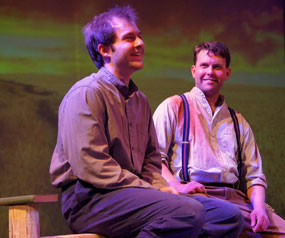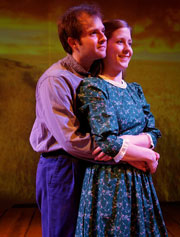Beyond the Horizon, directed by
Celeste Cosentino. Ensemble Theatre, Coventry Building,
Cleveland Heights, Ohio. April 25 - May 18, 2014.
The Ensemble Theatre's Beyond the Horizon tells
the story of the spiritual, physical and material
deterioration of the Mayo family over eight years, using
projections as one of the key stage elements.
The premiere of the playwright’s first full-length play
on Broadway in 1920, which won him a Pulitzer Prize,
transformed O'Neill from a Provincetown Players' writer
to one of the major American playwrights of the early
twentieth century. Critics of the time were fascinated
by this tragic saga which contains many challenges and
problems in staging. In his 1920 review, Heywood Broun
of the New York Tribune stressed that O'Neill
deserved attention although he saw some "signs of
clumsiness” because “the young man has not mastered the
tricks of his trade" (New York Tribune, 4
February 1920) and in his review for the New York
Times in 1920, Alexander Woollcott wrote that the
play was “possessed of elements of greatness” in spite
of “all its looseness and a certain high-and-mighty
impracticability” (New York Times, 8 February
1920).
The play is well-structured with a simple plot line
which documents an eight year period on the Mayo Farm in
Massachusetts beginning in 1907. The central character,
Robert Mayo, is an amalgam of O’Neill and his
imagination. The play addresses the question, what if
O’Neill did not have a chance to live—on and off—in New
York for five years? What if O’Neill had not been sent
to Central America by his father James, who sought “the
gold-mining potential of a family investment property in
the Spanish Honduras” (Roger J. Stilling, Dictionary
of Literary Biography)? What if O’Neill had not
joined the crew of the sail-driven cargo ship Charles
Racine for a 65 day, 5,900-mile voyage from Boston to
Buenos Aires? The character of Robert is an O’Neill
without these experiences in foreign lands and at sea.
Instead, O’Neill gave, in the play, these adventures to
the character of Andy, Robert’s elder brother.
The source of this question of the effect in changed
circumstances for O’Neill is based on his conversations
with a Norwegian seaman whom he met on the Charles
Racine. In a letter sent to a friend of O’Neill
(published in the New York Times in 1920), he
stated that he had been inspired by a Norwegian A.B.
whom he met on the British tramp steamer. O’Neill
described it as follows: “The great sorrow and mistake
of his life, he used to grumble, was that as a boy he
had left the small paternal farm to run way to sea. He
had been at sea twenty years and had never gone home
once in that time. I don’t imagine he had written home
or received a letter from there in years” (“A Letter
from O’Neill,” The New York Times, 11 April
1920). O’Neill described this seaman as a “bred-in-the
bone child of the sea,” in “perfect harmony with his
environment”; with “his feet on the plunging deck, he
was planted like a natural growth in what was ‘good
clean earth’ to him” (Letter, 11April 1920). What
attracted O’Neill was the way this man “cursed the sea
and the life [which] had led him—affectionately” and how
much “[he] loved to hold forth on what a fool he had
been to leave the farm.” This Norwegian fellow became a
model for both Robert and Andy Mayo in Beyond the
Horizon.
In the first act of the play, Robert and Andy make a
tragic mistake on the evening before Robert’s departure
for the East on a ship with his uncle. Andy has not
questioned his life as a farmer on the Mayo farm.
Robert, a poet and dreamer, has aspired to see the world
beyond the horizon especially after his father made him
leave college for financial reasons.
Yet, in spite of his genuine love for adventures and
freedom, Robert is turned from his course by what to
him, at that time, seems his love for the daughter of a
deceased neighbor, Ruth Atkins. Not being able to bear
the idea of his younger brother marrying Ruth, whom he
secretly loves, Andy decides to take the place of Robert
and sets out to the sea. The consequences of these
decisions are demonstrated in the tragic ending; when
wasted by the tuberculosis and hating his confinement in
a small bedroom to die, Robert crawls out to the country
road running by the farm to see, for the last time, the
horizon. Andy then accuses Ruth, of causing his
brother’s death because she has confessed to him that
she had told Robert that her marriage to him was a
mistake since she never loved him.
In the small theatre space in the Coventry Building in
Cleveland Heights—the home of Ensemble Theatre―the vast
yellow fields, interior of the house, and the sunset of
the play’s scenes were projected on the backdrop.
Additionally, instead of using a child actor for the
role of Mary, Robert and Mary’s infant daughter,
director Celeste Cosentino and projection designer Ian
Hinz used film footage to illustrate interactions
between Robert (James Rankin) and Mary (Catherine
Elersich).
The use of cinematic techniques in the production is in
line with O’Neill’s own life -long interest in the
cinema and his “interest in discontinuous space” as used
in film (Richard Hayes “Towards a ‘New Stage Craft’:
Eugene O’Neill and Some Aspects of the Early Narrative
Cinema” Eugene O’Neill Review 31 (2009):51).
Drawn to cinematic possibilities, O’Neill alternates, in
Beyond the Horizon, between indoor and outdoor
scenes. This results in a sense of discontinuity as well
as extended breaks between scenes. This is what
Alexander Woollcott, in his review in February 1920 for
its Broadway premiere, criticized: “Certainly it was a
quite impractical playwright who split each of these
three acts into two scenes, one outside and one inside
the Mayo farmhouse.” (New York Times, 8 February
1920).
Considering this impractical scene locations in each
act, the choice of Ensemble Theatre to use of
projections provides a practicability that O’Neill’s
script lacks. It also solves one of the biggest problems
for a small theatre company--an infant actor, thus
overcoming another of the “impractical elements” of
O’Neill’s dramaturgy. The original production used a
“ten or twelve” year old actress named Elfin Finn to
play the two-year-old Mary, according to Woollcott.
Yet the projected still and moving images added a sense
of dissonance with the time period of the play. The
moving images also added an eerie ambience which may not
be suitable for the production of O’Neill’s classic,
since his world is, no matter how we stretch our
imagination, is not a gothic romance or occult one. For
example, the image of "Mary"—much larger than an actual
girl—suddenly appeared on the backdrop, crying “Dolly,
Mama! Give Mary Dolly,” creating a rather chilly,
Bröntian or Joyce Carol Oatesian moment. The still image
of the house interior failed to serve the purposes of
the play, since according to the script, the interior is
supposed to show a gradual decay, reflecting that of the
characters.
Besides being overpowered by the projections, the
lighting was one of the weaker elements of this
production; it was too dark (especially upstage) to see
the actors' expressions. In addition during the entire
show, two spots in the auditorium were lit, illuminating
the backs of two patrons. I anticipate these concerns
will be addressed as “things to improve” (i.e., lighting
fixtures might have been placed too low to keep enough
throw distance) in the future of this small but
important regional theatre company in Cleveland.
The strongest element of this production was the
ensemble of the talented actors. Emily Pucell’s
portrayal of Ruth showed her change from a cheerful,
healthy young woman to a tired and depressed farm-wife,
whose hope is to “redo” (undo) her mistake by pursuing a
strong, and reliable Andy played by Keith E. Stevens.
 |
 |
|
James
Rankin (Robert Mayo) and Keith E. Stevens
(Andy Mayo). Photographs by Celeste
Cosentino. |
James Rankin
(Robert Mayo) Emily Pucell (Ruth Atkins). |
Rankin’s Robert and Stevens’s Andy
demonstrated changes over time in appearance via
costumes and make-up but they could have showed, more
vividly, internal conflicts of these characters in each
scene. Robert Hawkes—who played the role of James
O’Neill in the Ensemble Theatre production of Long
Day’s Journey Into Night in 2005—convincingly
portrayed the patriarch in his last bastion, the Mayo
Farm. Valerie Young’s Katie Mayo portrayed motherly
concerns for her younger son and keen insights in Act I,
and her compromise and self-deception in Act II.
As the first show of the 2014-15 season Ensemble Theatre
will stage O’Neill’s Anna Christie, directed by
Ian Hinz (set and projection designer of this show). I
look forward to the opportunity to attend another master
piece of O’Neill, which premiered in November 1921, less
than two years after the opening of Beyond the
Horizon.